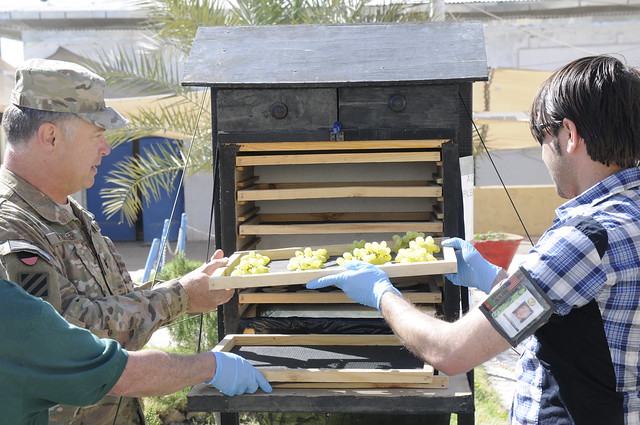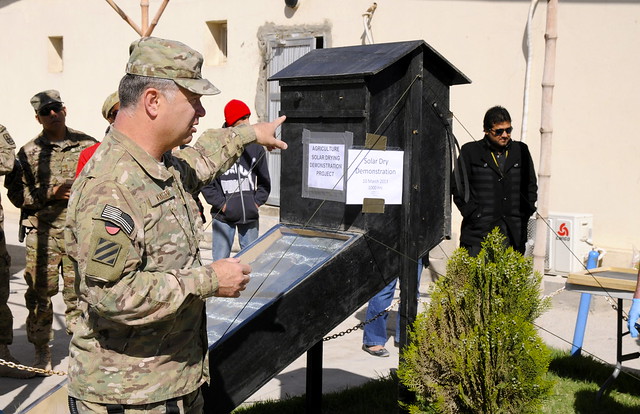Story and photos by Sgt. 1st Class Joseph Wilbanks, 1st Armored Division Public Affairs
[caption id="" align="aligncenter" width="576"]

Lt. Col. Dallas Kratzer with Kentucky's Agribusiness Development Team 5 assists with a demonstration for local farmers to show the proper methods of preserving fruit in Kandahar, Afghanistan, March 10, 2013. The project was in cooperation with the Kandahar Provincial Reconstruction Team. (U.S. Army photo by Sgt. 1st Class Joseph Wilbanks)
KANDAHAR, Afghanistan -- The Kandahar Provincial Reconstruction Team (KPRT) demonstrated a better fruit drying method for Afghan farmers at Camp Nathan Smith March 10, 2013.
This solar-powered fruit dryer could help the Afghans preserve fruit in a more sanitary fashion that is also faster than the traditional method used by Afghan farmers.
But it’s not just about a faster method for John E. Loyd, an agricultural advisor for the USDA and member of the KPRT.
“This is not only a better method, it also is much more sanitary and effective. It also will produce a marketable product for the Afghans. It’s just a better technique that gives a better yield.”
The traditional method used by Afghans was a single sheet of plastic or metal that the fruit was laid on to dry. The solar-powered boxes built by the KPRT allow for multiple layers to be stacked on top of each other. It reduces the time from five days to about three days. The box also keeps insects out, which makes for a much more sanitary product.
[caption id="" align="aligncenter" width="576"]

Lt. Col. Dallas Kratzer with Kentucky's Agribusiness Development Team 5 discusses the operation of a solar dyer for drying fruit during a demonstration for local farmers in Kandahar, Afghanistan, March 10, 2013. Afghan farmers on average lose 40 percent of their crops because of poor methods in preservation. (U.S. Army photo by Sgt. 1st Class Joseph Wilbanks)
This allows the Afghans to retain more of their harvest and produce a product that can be sold in neighboring countries. Most of the dried fruit produced in Afghanistan currently would not pass inspection to be sold internationally due to the way it is dried. The solar boxes will help remedy that as well as prevent waste.
“About 40 percent of what the Afghans grow is lost to spoilage and this is a way to prevent that,” said Air Force Lt. Col. Dallas F. Kratzer II, the Kentucky Agribusiness Development Team Liaison Officer to the KPRT.
This will also help supplement the diet of the people of Afghanistan through the winter
“They don’t have cold or cool storage normally, but by drying the fruit it retains a lot of the nutrients,” said Kratzer. “It’s a way to have sustainable nutrition throughout the year.”